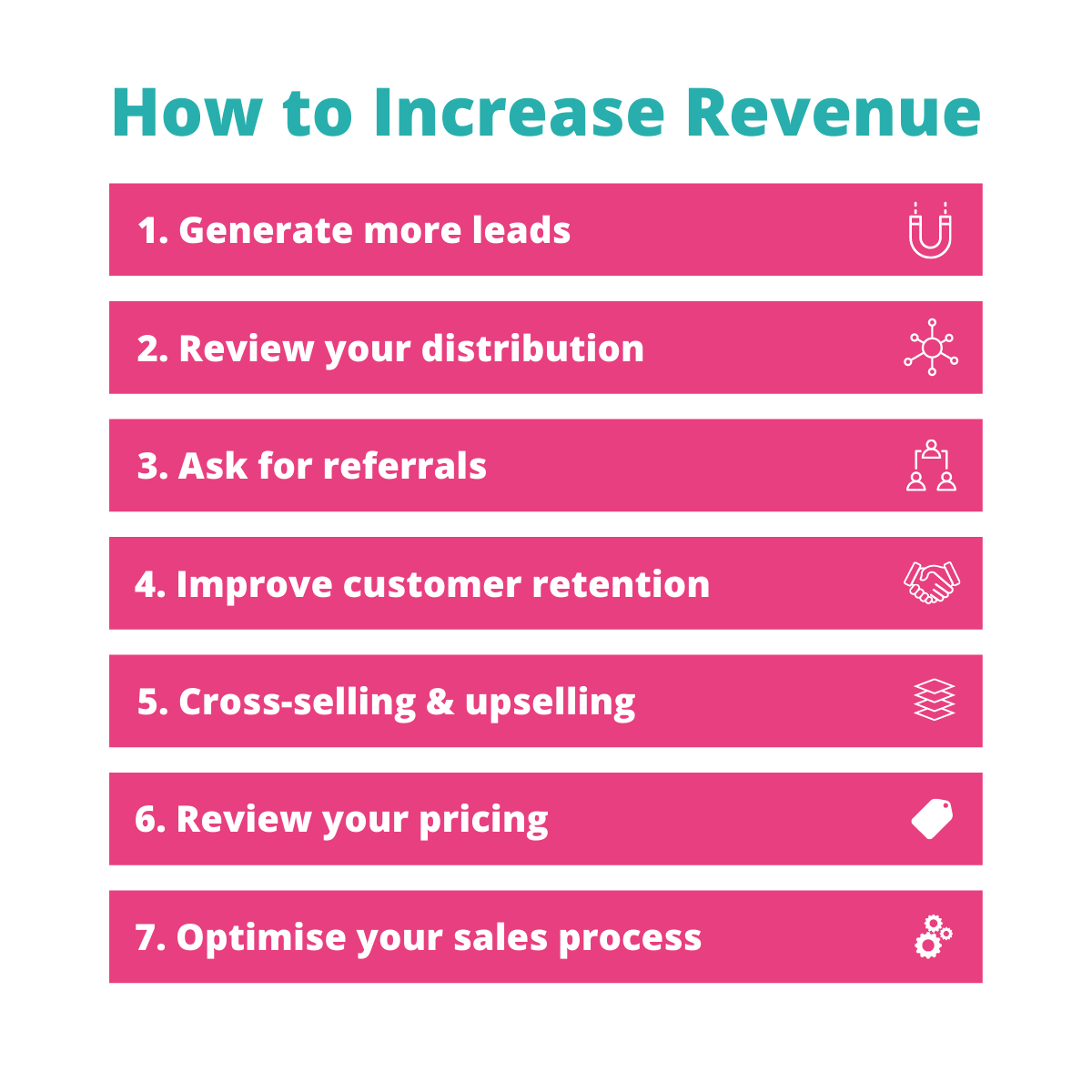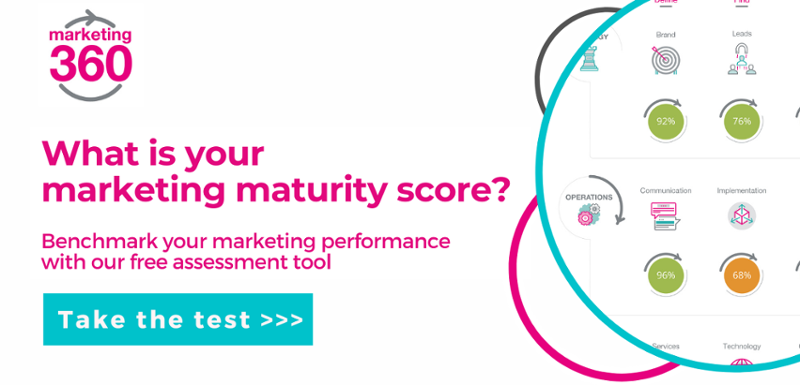A lot of business owners approach us with the same goal: “I want more leads so I can grow the business."
Lead generation is an important way of growing your business revenue. But it’s not the only way, and other options often get overlooked.
In fact, at some point generating even more leads is neither feasible nor cost-effective. Thankfully, most of the time, there are still other things you can do.
Here are seven ways to grow your customer base and volume of sales - including six that you can turn to once you’ve exhausted all your lead generation possibilities:
- Generate more leads
- Review your distribution
- Ask for referrals
- Improve customer retention
- Cross-selling and upselling
- Review your pricing
- Optimise your sales process
#1 - Generate more leads
Let’s start with the most obvious one: generating more leads.
We’ve written a lot about lead generation (we’ll round up some links below). But if you’re looking to improve your lead generation performance, here are a few good places to start.
Identify your top-performing channels
This may sound obvious, but it’s worth sharing. Find your top-performing lead generation channels and double-down on them.
For example, if your website or other online presence (such as LinkedIn) has a high conversion rate, ask how you can get more traffic to it. If you’ve found that webinars are a good way to meet potential customers, look into running them more frequently.
While you’re at it, you should also review the channels or tactics that aren’t performing well and ask yourself:
- What can you do to improve performance?
- Should you reallocate budget to tactics that are more successful?
Make your campaigns more targeted
There are very few one-size-fits-all lead generation solutions. But one general principle is that if you want to improve the performance of your lead generation activity, make it more targeted.
There are lots of different ways to do this.
You can zero in on a specific sector you’ve had success with in the past. You can target specific pain points or challenges. You can target people regionally, or look at a certain level of seniority.
The right answer will depend on your business and your buyer. But you will almost always get more traction by targeting a specific audience with a message that’s highly relevant to them.
If you’re looking for more information on lead generation, we recently published some original research into the UK’s top lead generation tactics. You might also want to check out these five cost-effective lead generation strategies.
#2 - Review your distribution channels
Distribution channels vary by sector, but here are a few common examples:
- Wholesaler distributor - selling to businesses who sell on to other businesses
- Retailers - selling to businesses who sell on to consumers
- Resellers - signing agreements with partners who then sell on your behalf
Finding new distribution channels or making better use of the ones you have is a proven way to increase revenue. Let’s look at each of these in turn.
Existing distribution channels
Track distributor performance
Your sales reporting should be able to tell you which distribution channels your leads and customers are coming from.
You can then find your top-performing distribution channels and double down on them. Or find the ones that aren’t performing and pull them, or improve their performance.
Hold reviews with your distributors
Arrange regular reviews with your distributors to discuss your results and whether there’s anything you can do to help them sell for you.
Depending on the relationship you have with them, you could also set targets and offer incentives based on sales performance.
Make it easier for them to sell for you
Create sales enablement material such as brochures, point-of-sale displays or case studies that they can share with customers. You can also create offers or discounts to help them drive demand.
New distribution channels
The most consistent way to find new distribution channels is to speak to your customers. Asking them where else they go to find products or services like yours is a reliable way to find new opportunities.
Paying attention to the ads in relevant trade publications or websites is another way to find distribution channels who are actively trying to reach your end buyers.
Looking for something you can share with your team? Here’s a handy checklist.

#3 - Ask for referrals
Remember to ask!
The only referrals you definitely won’t get are the ones you don’t ask for.
It might feel a bit uncomfortable at first, but referrals are a tried-and-tested way of growing your revenues. So get in the habit of asking for them.
If you’re wondering how to do this, here’s an example call script you could use. In our experience, it’s best done over the phone. Ideally, just after a favour or good deed (learn more about the principle of reciprocity).
“We’re really pleased with the work that we’ve done together and the results we’ve got so far.
“I hope you don’t mind, but I was wondering if you have any contacts who would benefit from our work in the same way that you have. If so, a referral or introduction would be very much appreciated.
“But if you’d rather not, no worries.”
Offer referral incentives
Another way to drum up referrals is to offer existing customers incentives to pass you on to their contacts. These incentives can be discounts, upgraded products or services or gifts.
Track referrals
Set up your CRM to track referrals as a lead source. This will help you keep track of how your referral programme is doing and which tactics are having the most impact.
#4 - Improve customer retention
Monitor and analyse churn (for recurring revenue businesses)
Your sales data will be able to tell you the points in the customer lifecycle where you’re losing customers.
If you find that customers tend to drop off at a certain point, ask how you can improve the experience or provide more support there. Proactive interventions are a proven way to increase retention - and if you automate them, they’re also scalable.
Re-engage past customers (for one-off businesses)
You can use your CRM to set reminders to check in with customers after a sufficient amount of time has passed for them to be back in the market.
If you’re looking for more advice on retention, check out these 8 ways to build customer loyalty.
#5 - Find cross-selling / upselling opportunities
Create bundles
Even if you don’t sell your products or services as bundles, you should know which of your products or services are complementary and try to make sure you’re marketing and selling them together.
Segment your customers by product or service
Once you’ve defined your product or service bundles, you can analyse your sales data to see which products or services your customers bought.
You can then cross-reference this with the bundles you’ve created, which will show you other products they might be interested in.
Create processes around cross-selling / upselling
Salespeople tend to be naturally opportunistic and will spot opportunities themselves. But creating processes around cross-selling and upselling will help make sure you’re not missing out on opportunities.
Get more advice on encouraging current customers to spend more.
Note: Want to speak to an experienced marketer about growing your business’ revenue? Our part-time Marketing Directors are here to help. Book a free one-hour consultation.
#6 - Review Your Pricing
One of the most obvious ways to impact your bottom line is to revisit your pricing strategy. But whether you’re increasing prices to improve profit margins, or dropping prices to encourage customers to buy, you need to tread carefully.
Increasing prices
Small incremental adjustments made on a regular basis is much better than raising your prices drastically overnight. Customers tend to respond poorly to serious changes in your pricing, so if you do make changes, make sure the conversation is handled in the right way.
If you’re wondering whether your pricing is right, check out this handy list of questions that will help you price your products or services more effectively.
Dropping prices
The only good reason to drop your prices is to drive short-term demand. If you are doing this, make sure you don’t cheapen or undermine your brand, as it can look a bit desperate, especially if you’re a service business.
Price anchoring and hierarchy
Price anchoring is when you give customers alternative price points that make the actual price more appealing. The most common price anchoring technique is a price promotion or a sale. Normally a product is £10 (the anchor), but today it’s just £7.
An alternative is tiered pricing. The Basic package is £40 a month, the Pro package is £50 a month and the Enterprise package is £100. The anchors on either side of the Pro package make it seem like a better deal. It’s only slightly more expensive than the Basic package and a lot cheaper than Enterprise.
Another example could be a direct comparison with your competitor, assuming that their price (the anchor) is more than yours.
Pricing is a complex topic. If you want more information, check out our On-Demand webinar with David Abbott, the author of How to Price Your Platypus.
#7 - Optimise your sales and marketing process
Optimising your sales and marketing process is about making the experience as frictionless as possible. This tends to come down to three things:
- The ratio of enquiries or responses to marketing campaigns that become sales leads
- The average time it takes for a lead to become a customer
- The average ratio of leads that become customers
Here are a few ways to optimise these metrics.
Have a process for handling new opportunities
Your marketing team should have a repeatable and measurable process for engaging new enquiries or opportunities as soon as they come through.
Your goal should be to qualify whether the lead is a genuine sales opportunity and, if so, pass it on to sales as quickly as possible, along with all the information your sales team will need.
You should also make sure that the prospect’s first interaction with your company is a good one.
For instance, if they fill out a form, they should receive an autoresponder email letting them know that you’ve got their message and when they can expect a response by.
You may also want to share some relevant content with them so that you’re adding value right away. Little touches can make a big difference.
Define the buyer journey
Before you can optimise the sales process you need to define it. There are lots of ways to do this, but the simplest is to define at which point a person goes from being a marketing qualified lead to a sales qualified lead to a customer.
Here are some example definitions:
- Marketing qualified lead (MQL) - a potential customer who’s interested in your company and can be reached by your team
- Sales qualified lead (SQL) - a potential customer who has shown intent to buy
- Customer - someone who has bought from you in the past and may do again
Every company will have slightly different criteria for what constitutes a MQL and a SQL. If you could do with revisiting your buyer journey, here’s a more detailed explanation of how to define a lead for your business.
Set up reporting in your CRM
Your CRM should be able to track leads as they proceed through the sales process. Set up dashboards so that your team can easily track their sales and marketing efficiency.
This also makes it easier to hold sales and marketing to account if things aren’t improving.
Don’t abandon old leads
Your pipeline probably has hundreds if not thousands of ‘closed lost’ leads in it. Each of those leads is an opportunity.
A key way of improving your sales efficiency is to find ways of re-engaging the leads that you already have. Every lead in your CRM should have a ‘next action’ against it.
The motto we use with our own sales is ‘no lead left behind’. Check out our recent post for ideas on how to re-engage stalled leads in your pipeline.
Lead generation may get the most airtime when it comes to increasing sales and hitting revenue goals. But generating new leads takes time and it can be a bit unpredictable, especially if your processes aren’t well-defined.
By exploring all the options mentioned in this guide, you might find opportunities to increase your profit margin that are closer to home.
What’s your Marketing Maturity Score?
Take 10 minutes to understand your marketing performance and identify areas to prioritise with our Marketing 360 Assessment.
You’ll get a detailed report breaking down your performance, full of personalised advice to help you improve any areas where you’re struggling. We also offer a free consultation to help you interpret your results and turn them into an action plan.
Click here to get your Marketing Maturity Score.





